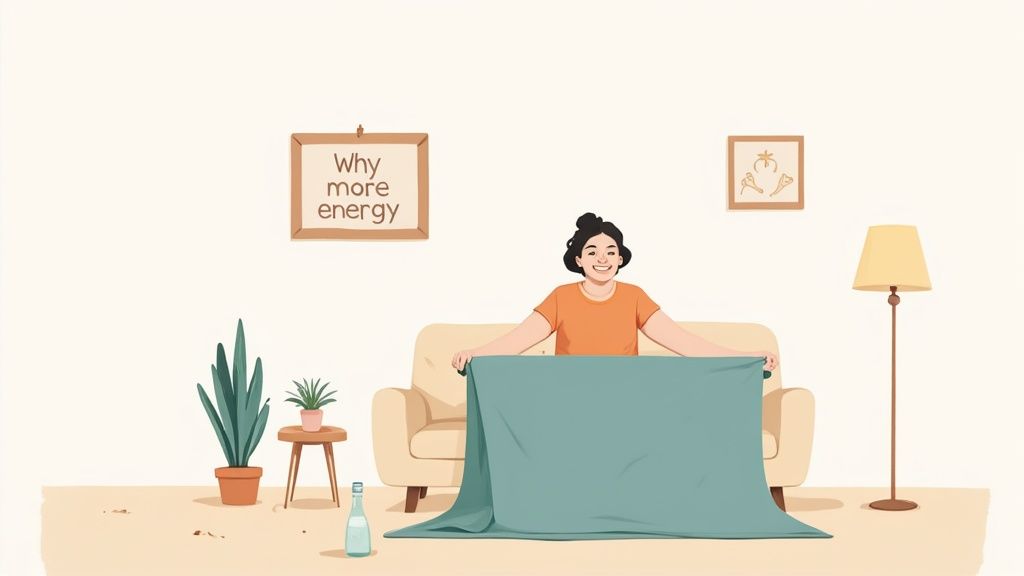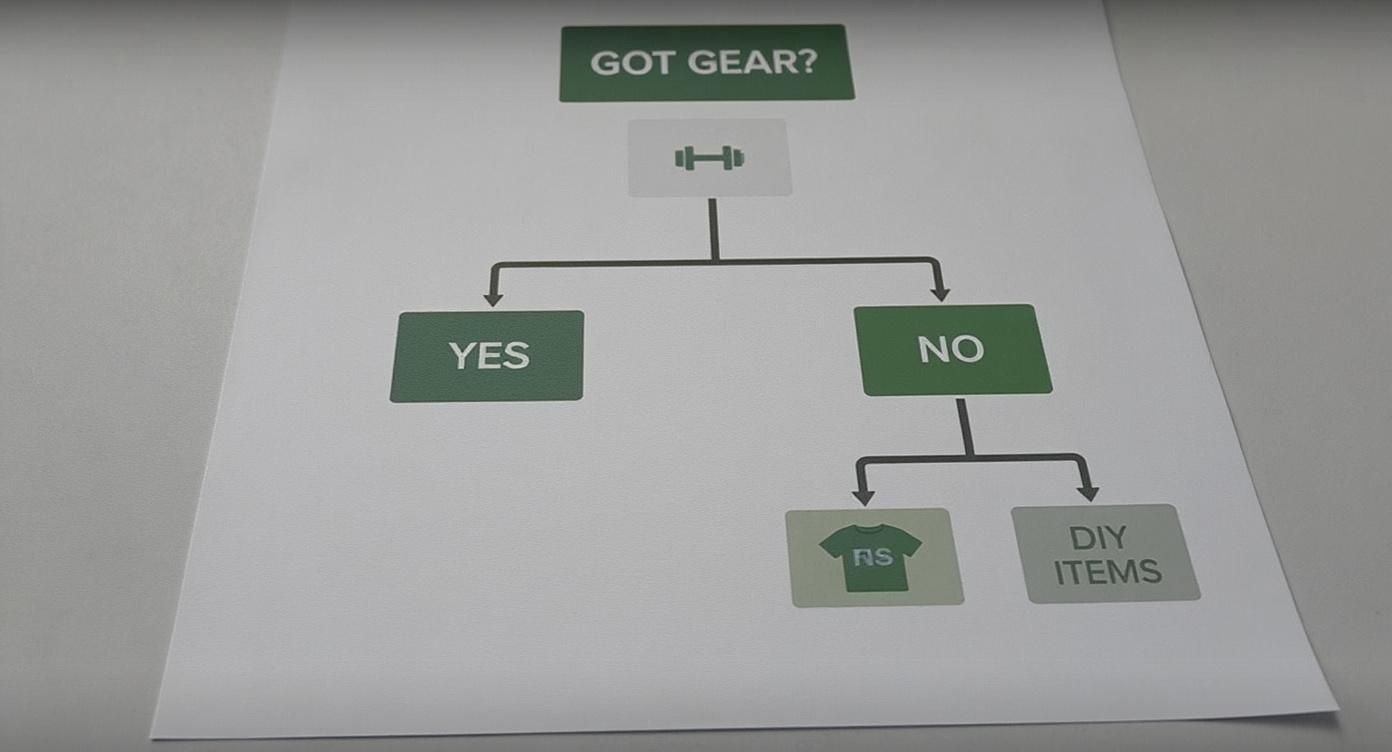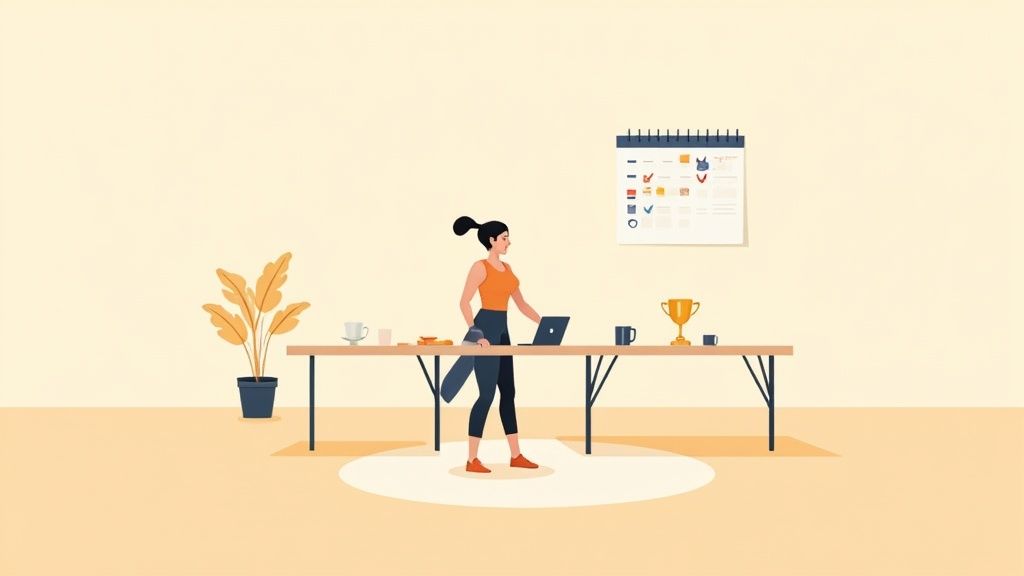Every great workout routine for home has four key parts: a solid warm-up, a strength section, a bit of cardio, and a proper cool-down. Nailing this simple structure is your ticket to building muscle, boosting heart health, and keeping injuries at bay, all without leaving your house.
This guide gives you everything you need to build that foundation. You'll learn how to set smart goals, pick the right exercises, and create a weekly schedule that fits your life—no gym membership required.
Building Your At-Home Fitness Foundation

Starting a fitness journey from home can feel like a big step, but it all begins with a simple, personal plan. Forget the complicated routines you see online. The home workout programs that actually stick are the ones built on a clear understanding of why you’re doing it in the first place.
This isn’t about chasing an impossible ideal. It's about figuring out what truly motivates you. Do you want more energy for your kids? Do you want to feel stronger carrying groceries? That personal "why" is the secret sauce that keeps you showing up long after the initial excitement fades.
Define Your Starting Point
Before you do a single push-up, you need a destination. Setting clear, realistic goals turns a vague wish into a concrete plan. Instead of something fuzzy like "get fit," let's get specific.
Here are a few practical examples to get you started:
- Energy Goal: "I will do a 20-minute workout three times this week to beat the afternoon slump."
- Strength Goal: "By the end of this month, I will be able to hold a plank for 30 seconds."
- Consistency Goal: "I will stick to my schedule and not miss more than one workout for the next two weeks."
These small victories build real momentum. They prove you can do it, which makes tackling the next goal feel completely achievable.
The Power of a Balanced Routine
A truly effective workout routine for home is more than just random exercises. It's a balanced cocktail of movement that challenges your body in different ways.
The secret to sustainable results lies in combining strength training to build metabolism-boosting muscle, cardio to keep your heart strong, and mobility work to ensure your joints stay healthy and injury-free.
And if you're choosing to work out from home, you're in good company. As of 2023, it has officially become the most popular fitness location in the U.S., with 51% of exercisers now preferring it over the gym. This massive shift proves just how effective a smart home fitness plan can be. You can dive deeper into these home fitness trends and see the full research.
Let's use this as our blueprint for crafting a routine that fits seamlessly into your life.
Your Minimalist Home Workout Toolkit (What You'll Need)
Forget the idea that you need a room full of bulky machines to get a great workout. Here at Bare Fitness, we’re all about keeping things simple. Building an effective workout routine for home is about being resourceful, not spending a fortune.
The idea of working out at home isn't a niche concept anymore. The global market for at-home fitness gear hit a staggering USD 9.34 billion in 2024 and is on track to nearly double over the next decade. You can read more about this growing market for at-home fitness gear if you're curious.
This shift is why we focus on simple, versatile tools, like the ones you see on our own equipment page.
As you can see, we’re not talking about treadmills or complex machines. We’re talking about essentials like yoga mats and resistance bands that give you maximum results without cluttering your living room.
The Must-Have Essentials
If you’re going to buy anything, start with these two game-changers. They are the bedrock of countless exercises, adding both comfort and a serious challenge.
A Supportive Yoga Mat: This is more than a yoga accessory. A quality mat protects your joints—think knees during lunges or your spine during core work. It also carves out a dedicated, non-slip "gym" space, which is a powerful mental cue to get in the zone.
A Set of Resistance Bands: I like to call these the ultimate portable gym. A good set with different resistance levels is incredibly versatile. You can add intensity to squats, mimic cable rows for your back, or zero in on smaller muscle groups like your shoulders and glutes. They’re light, affordable, and unbelievably effective.
Get Creative With Household Items
Before you click "add to cart," look around you. Your home is probably already stocked with everything you need.
The most powerful tool in your home gym is your creativity. Learning to see everyday objects as fitness equipment unlocks endless workout possibilities and removes the barrier of needing specialized gear.
A sturdy dining chair? Perfect for tricep dips. A couple of dish towels on a hardwood floor? You’ve just made your own sliders for core exercises. You can even use water jugs or a backpack stuffed with books as makeshift weights. The point is, an effective workout routine for home doesn’t require a big investment—just a little imagination.
How to Structure Your Workout Week
Consistency is where the results are. But a plan that shatters the second real life gets in the way is set up to fail. The best workout routine for home is flexible, bending when your schedule gets crazy instead of breaking.
It's all about finding a weekly rhythm that actually fits your life. This handy decision tree can help you see how to build a routine with whatever you have on hand.

Your starting point—whether you have dumbbells or just a floor and a can-do attitude—simply shapes your exercise choices. It doesn't stop you from getting a killer workout.
Here are a few proven ways to map out your week.
The Gentle Start Schedule (For Beginners)
If you're just starting, diving into a demanding schedule is a recipe for burnout. The goal here is simple: build the habit of movement. Forget about intensity for a moment and just focus on showing up.
Here’s a simple way to ease into it:
- Week 1: Start with two 20-minute workouts. Maybe a Tuesday and a Friday.
- Week 2: Feeling good? Add a third 20-minute day. Think Monday, Wednesday, Friday.
- Week 3: Now, bump up the time on those three days to 25-30 minutes.
This gradual ramp-up builds physical endurance and, just as importantly, your confidence. The most critical part of any workout routine for home is learning to listen to your body.
The 3-Day Full-Body Plan
Is your schedule already packed? This is your go-to. Efficiency is the name of the game, hitting every major muscle group in each session to get the most bang for your buck. It's a fantastic way to build a solid foundation of strength.
A typical week might look like this:
- Monday: Full-Body Workout
- Wednesday: Full-Body Workout
- Friday: Full-Body Workout
- Off Days: Focus on active recovery—a brisk walk or some deep stretching.
This setup guarantees 48 hours of recovery between strength sessions, which is the sweet spot for muscle repair and growth.
The 4-Day Strength and Cardio Split
Once the 3-day plan feels a bit too easy, you're ready to level up. A 4-day split lets you dedicate more time and energy to specific areas. One of the most effective ways to do this is with an "upper/lower" split.
Here's one way to arrange it:
- Monday: Upper Body Strength
- Tuesday: Lower Body Strength
- Thursday: Upper Body Strength
- Friday: Lower Body Strength
- Rest Days: Take Wednesday and the weekend off, or use one for light cardio.
This approach lets you really turn up the heat on each muscle group. It’s the perfect next step to keep pushing your progress forward.
Remember, the “perfect” schedule is the one you can actually stick with. Don't be afraid to shuffle your days around. A workout on Thursday is just as effective as one on Wednesday if that’s what your life demands.
Sample Weekly Workout Splits
Choose a weekly schedule based on your time availability and fitness goals. Mix and match days as needed, but prioritize consistency and rest.
Feel free to use these templates as a starting point. The key is to pick a structure, try it for a few weeks, and adjust based on how you feel.
Mastering the Core Bodyweight Exercises

A truly effective workout routine for home isn't about learning dozens of complicated exercises. It’s about getting really good at a handful of foundational movements that build real, functional strength.
Think of these as your "non-negotiables." When you master the form, you make every repetition count, which is how you get results safely and efficiently. Let's break down the key players.
The Perfect Bodyweight Squat
If you do nothing else, learn to squat. It's one of the most fundamental human movements—you do it every time you sit down and stand up—making it incredibly practical.
How to Do It (Step-by-Step):
- Stand with your feet just wider than your hips. Toes can point straight ahead or slightly outward.
- Brace your core like you're about to be poked in the stomach and keep your chest lifted.
- Initiate the movement by pushing your hips back, as if you’re aiming for a chair behind you.
- Lower yourself until your thighs are about parallel to the floor. Go as low as you can while keeping your back straight.
- Drive through your heels to push back up, squeezing your glutes at the top.
Common Mistake to Avoid: Don't let your knees collapse inward. Actively push them out so they track over your feet. This protects your knee joints and ensures your glutes are working.
Push-Up Variations for Every Level
The push-up is the undisputed king of upper-body exercises. It hits your chest, shoulders, triceps, and core all at once. The best part? It's infinitely adaptable.
- Beginner (Wall Push-Ups): Face a wall and place your hands on it, slightly wider than your shoulders. The further you stand from the wall, the harder it gets.
- Intermediate (Incline or Knee Push-Ups): Once wall push-ups feel easy, move to a sturdy countertop or do them on the floor from your knees. This is a great way to build strength.
- Advanced (Standard Push-Ups): The classic. Aim for a perfectly straight line from your head to your heels. No sagging hips!
Your goal isn't just to pump out more reps; it's to own every single one. A slow, controlled push-up builds far more muscle than ten sloppy ones. Focus on "time under tension" to create change.
Lunges for Balance and Strength
Lunges are fantastic because they work each leg on its own. This is a secret weapon for fixing muscle imbalances and improving your overall stability.
Quick Form Cues:
- Take a confident step forward, keeping your torso tall.
- Drop your hips down until both knees form a rough 90-degree angle.
- Check your front knee—it should be stacked right over your ankle, not shooting past your toes.
- Powerfully push off that front foot to return to the start. Then, switch sides.
The Plank and Glute Bridge
No workout routine for home would be complete without direct core and glute work. These two moves build a rock-solid midsection and a strong posterior chain, which helps protect your lower back.
Plank: This isn't about speed; it's about endurance. Get into a push-up position (on hands or forearms) and hold. Keep your core tight and your body in one straight line. Fight the urge to let your hips sag or poke up.
Glute Bridge: Lie on your back, knees bent, feet flat on the floor. Drive through your heels and lift your hips toward the ceiling. At the top, give your glutes a powerful squeeze. This is one of the best exercises for waking up dormant glute muscles, especially if you sit a lot.
How to Stay Motivated When No One Is Watching

The first few weeks of a new workout routine for home are a honeymoon period. But what happens on week six? It's a rainy Tuesday morning, and your bed has never felt more comfortable. That's the moment that truly defines your progress.
Motivation isn't a mystical force; it's a skill you cultivate. When you work out at home, you are your own accountability partner. There’s no trainer checking your form or a class full of people expecting you. This is why building a tough mindset is as crucial as building physical strength. The goal is to stop waiting for inspiration and start building durable habits.
Build Habits That Stick
The secret to staying consistent isn't superhuman willpower. It's smart planning. One powerful technique is "habit stacking." You tether your new workout habit to a solid, existing one.
For instance, instead of hoping you'll feel like working out, make it automatic:
- "After I brush my teeth in the morning, I will immediately change into my workout clothes."
- "As soon as I close my laptop for the day, I will start my 20-minute workout."
This trick removes the debate. Your workout routine for home starts to feel less like a chore and more like a non-negotiable part of your day.
A successful fitness journey isn't built on a few heroic, two-hour gym sessions. It's forged in the small, consistent actions you take every day, especially on the days you don't feel like it.
Track More Than Just the Scale (Progress Tracking)
Nothing fuels motivation like seeing progress, but if the only metric you're watching is the scale, you're setting yourself up for frustration. Your weight fluctuates daily for a dozen reasons.
Instead, start hunting for "non-scale victories." These are the real-world signs that you're getting stronger.
- Did you carry all the groceries inside in one trip? That's a win.
- Notice you have more energy to chase your kids around the park? That’s progress.
- Did you hold a plank for five seconds longer than last week? Huge victory.
Keep a running list of these wins in a notebook or a notes app. Looking back at this tangible proof of your hard work is an incredible mental boost.
It’s this desire for accessible, trackable progress that's fueling a massive shift in fitness. The global home fitness market is projected to skyrocket to nearly USD 19.79 billion by 2032. You can find more data on the rise of home fitness equipment on fortunebusinessinsights.com.
Answering Your Top Home Workout Questions
Let's tackle some of the common hurdles that come up when you start a workout routine for home. Getting these sorted out is key to building a plan you can stick with for the long haul.
Think of this as your personal cheat sheet for making home fitness a seamless part of your real, busy life.
How Long Should My Home Workouts Really Be?
This is the question I hear most often. The answer: consistency and effort trump a long workout, every single time. You absolutely do not need to carve out a full hour every day to see incredible results.
For most people, 20-30 minutes of focused effort, done 3-4 times a week, is the magic number. That's enough time to seriously challenge your body without rearranging your entire day. As you get fitter, you might push it to 45 minutes, but only if that feels right for you.
The perfect workout length is the one you can show up for consistently. A killer 60-minute plan you only do once a month is useless compared to a solid 20-minute session you knock out three times a week.
How Do I Know If I'm Actually Making Progress?
It's tempting to live and die by the scale, but it's the least helpful way to measure success. True progress shows up in ways that have nothing to do with your weight.
Instead, look for these real-world signs you're getting stronger:
- Performance Jumps: Could you do one more push-up than last week? Did you hold that plank for an extra 10 seconds? These small jumps are huge indicators of new strength.
- More Gas in the Tank: Do you have more energy in the afternoon? That's a sign your body is becoming more efficient.
- Everyday Life is Easier: Are groceries easier to carry? Can you chase your kids around without getting winded? This is functional fitness, and it's the ultimate goal.
Jot these victories down in a notebook. Celebrating these wins is what keeps the motivation high and reinforces that your workout routine for home is working.
What Happens If I Miss a Workout?
First, relax. Don't beat yourself up. Life gets in the way. The biggest mistake is falling into the "all-or-nothing" mindset, where one missed session turns into a week of inactivity.
Just get back on track with your next planned workout. Don't try to cram two sessions into one day to "make up for it"—that's a fast track to burnout or injury. Remember, consistency is built over months and years, not on being perfect every day.
Next Steps: Keep Building Your Momentum
You now have the complete blueprint for a successful workout routine for home. The key is to start small, stay consistent, and celebrate every small victory along the way. Your fitness journey is unique to you, so don't be afraid to adjust this plan to fit your life.
Ready for more?
- Explore our programs: Find guided workouts tailored to your goals.
- Read our blog: Discover more tips on nutrition, motivation, and minimalist fitness.
- Join the community: Connect with others on the same journey.
At Bare Fitness, our philosophy is simple: the best fitness plan is the one that flexes with your real life. We create straightforward guides to help you build a lasting fitness habit from home. To find a workout routine for home you'll actually love doing, check out all our resources at https://barefitness.com.



















